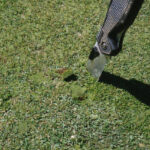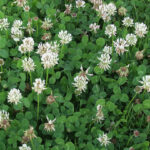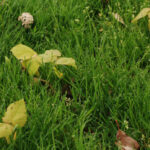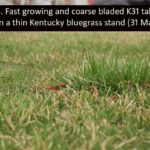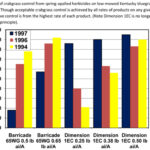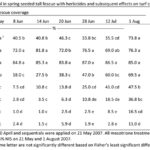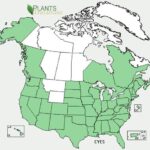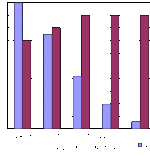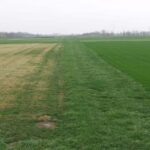Category: Weed Control
The somewhat random world of herbicide burn injury on turf
With weather drying out and heating up, the risk of herbicide burn is increasing. In most cases, herbicide burn is similar to fertilizer burn in that the concentration of the herbicide spray residue on the leaf literally sucks the water out of the leaf, desiccating the leaf. This is similar to how urea fertilizer spilled […]
Moss in greens
I’ve gotten a number of questions about moss lately. Moss is becoming more common in greens as we decrease mowing heights and nitrogen fertility in pursuit of faster green speeds. Moss becomes more competitive as creeping bentgrass becomes less competitive. Though the herbicide QuickSilver has become the industry standard when applied at 6.7 oz/A, a […]
Poa annua, Poa trivialis, and/or creeping bentgrass in lawns and sports fields
Poa annua (annual bluegrass), Poa trivialis (rough bluegrass) and creeping bentgrass are becoming common weeds in athletic fields and lawns. These weeds are important to distinguish because they require different controls. Poa annua: a winter annual that is lighter, more apple green than other lawn species. It is just past its aggressive seedhead stage, but you’ll likely still find […]
Southern IN: Controlling common lespedeza (Lespedeza striata)
A common concern in southern Indiana lawns is common lespedeza, which is a summer annual spreading by wiry stems from a single taproot forming almost a mat in thin turf or next to sidewalk. The most common broadleaf herbicide is 2,4-D, but this is completely ineffective against lespedeza. A recent report from John Boyd at […]
White Clover in Golf Courses, Sports Turf, and Lawns
The small white flowers of white clover are very visible right now and it may appear that clover is taking over, especially under-fertilized turf areas. Clover is a legume and is very competitive under low N conditions, so increasing annual N is best method to help exclude this weed. However, its spreading stolons make it […]
Volunteer tree seedlings in lawns?
I’ve gotten a number of calls asking about volunteer maple and other tree seedlings growing in lawns. These are direct descendents of a neighborhood tree whose seed pods released last spring/summer. You can either stake a couple of these small trees and nurture them over time to become a formidable maples, or you can control […]
Seeding into areas where preemergence herbicide was applied this spring
A fairly typical question now is, ”Can I seed into an area where preemergence herbicide was applied earlier this spring”. The answer is a very simple “No”. These herbicides are active in the soil for up to 120 days and their nature is to be absorbed into the root of a germinating weed (or turfgrass […]
Professionals Only: Spring Dandelion Control
Though fall applications are most effective for controlling broadleaf weeds, spring applications are warranted for new customers or areas that did not get treated last fall. Spring applications will be most effective if you wait until dandelions are at or near flowering, but still not as effective as fall applications. Applications before mid-April will only […]
Dandelions: Friend or Foe?
The annual bloom of dandelions is already here in southern Indiana and just around the corner in the rest of the state. Though some find dandelions attractive and some may actually eat them in salads or wine, others consider dandelions as weeds and try to control them in a lawn. The optimum time to control […]
Knotweed germinating next to sidewalks and other hotspots
Prostrate knotweed is currently germinating in thin areas next to sidewalks, cart paths, driveways and other hotspots. Knotweed is often confused with crabgrass at this early stage. Knotweed leaves have rounded leaf tips whereas crabgrass has leaf tips that come to a dull point (See photos). Crabgrass also has veins running lengthwise (parallel veination) whereas […]
For professionals only: Poa annua seedheads
Poa annua seedheads are just around the corner in most of Indiana and it’s high time to apply Embark or Proxy/Primo for seedhead reduction on golf courses. The seedhead models on our GDD Tracker at http://www.gddtracker.net indicate most of Indiana should be applying now. Embark and Proxy/Primo can effectively reduce seedheads of Poa annua, which tends to allow the Poa to […]
Lots of Colors in Spring Lawns
During spring green-up, lawns may reveal many variations in color, growth rate, and leaf width. This variation can be due to some of the following reasons: Species and cultivars: Perennial ryegrass is always the first of the desired cool-season grasses to green-up, followed by tall fescue and eventually Kentucky bluegrass (Fig. 1). Even within a species, […]
Seed now to get a jump on crabgrass germination
Though spring is not our favorite time to seed, it’s important to seed as soon as possible to allow the cool-season grasses to germinate prior to crabgrass. Crabgrass germinations can occur at soil surface temperatures as low as 50F, but germination is slow and these plants (hopefully) may be killed by an ensuing frost. Most […]
Professionals Only: Premergence herbicide strategies
As spring is closing in, we are fielding a number of questions; four major questions right now: Which preemergnce herbide to use? That one is pretty easy. We have only three active ingredients relatively easily available and they are dithiopyr, pendimethalin, and prodiamine. Our research shows that as long as they are applied at reasonable […]
Preemergence Yellow Nutsedge Control In Spring Seeded Tall Fescue With Tenacity, Dismiss and Echelon, 2007
Summary: This study showed that Dismiss and Echelon provided excellent preemergence yellow nutsedge control, but these herbicides should not be used in a tall fescue seedbed. Tenacity applied twice at 0.1 87 lb/A provided a level of yellow nutsedge control similar to Dismiss and Echelon. However, Tenacity works slowly and must be applied twice to […]
Yellow Nutsedge, The Scourge of Lawns and Landscapes in Nebraska
Yellow nutsedge (Cyperus esculentus) is a common, persistent and troublesome weed in lawns and landscapes in Nebraska. This is especially true from Kearney east into Iowa. Yellow nutsedge thrives in waterlogged soil and their presence often indicates that drainage is poor, irrigation frequency/quantity are excessive, or sprinklers/valves are damaged and leaking. Once this tenacious weed […]
Yellow nutsedge may be far off concern, but spring applications show promise
Yellow nutsedge is now one of the most common weeds in lawns, athletic fields and golf turf. Even though all textbooks say it thrives in wet areas, we see some of our worst yellow nutsedge infestations in dry years. Cultural controls will always help, but the standard herbicides are Basagran, SedgeHammer (formerly Manage), Certainty, and […]
Choosing a Preemergence Herbicide
There are many, many formulations and combinations of preemergence herbicides available for the professional. Following are some suggestions for purchasing and using preemergence herbicides. Control from every preemergence herbicide can vary from year to year, or location to location. Therefore, you can’t judge the performance of a product or a specific rate of that product […]
How Late is Too Late to Control Dandelions and Other Weeds?
Even though the drought has limited some broadleaf weed applications this month, we are now in the prime season for broadleaf weed control. Actually there is plenty of time left for good control. Nebraska research reported in 2002 showed 2,4-D and/or dicamba were far more effective in controlling dandelions and Canada thistle when applied 1 […]
Color Variation in Residential and Commercial Lawns
During spring green-up, home lawns may reveal many variations in color, growth rate, and leaf width. This variation can be due to some of the following reasons: Species and cultivars: Perennial ryegrass is always the first of the desired cool-season grasses to green-up, followed by tall fescue and eventually Kentucky bluegrass. Within a species, different […]
